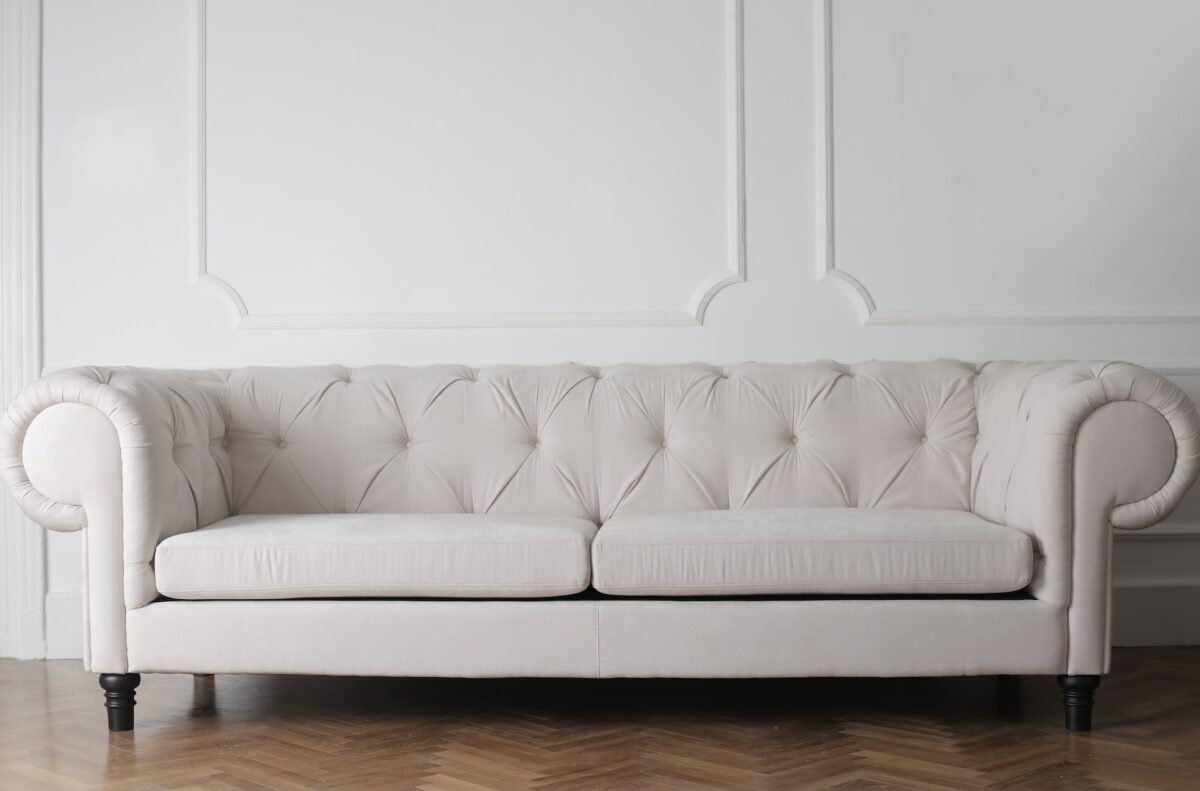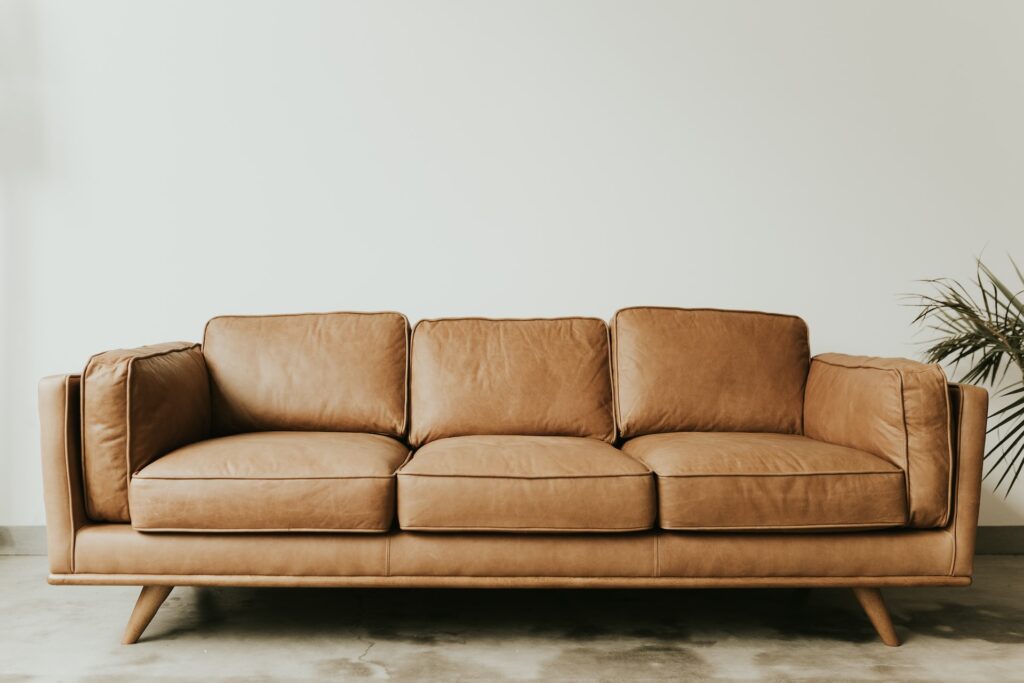
October 25, 2022
How to Clean a Couch: Fabric, Leather, Microfiber & More
Couches bring so much comfort into our lives, supporting us when we cuddle with the dearest ones and binge-watching TV. However, such an intimate connection takes a toll on the couch condition, leaving it covered with everyday spills, crumbs, pet mess, dirt from our hands and feet, and even make-up… With our simple couch cleaning guide, it will be even easier for a couch potato to tackle the cleaning of a messy couch and cushions, whatever they are made of.
Couch Cleaning Basics
Just like your favorite pair of jeans, a couch has a care label you have to obey while cleaning. The letter “W” means you can wash upholstery using water. “S” means only solvent-based cleaning supplies are allowed. “WS” logically means both water and solvents are ok, while “X” means that a couch requires professional cleaning (but vacuuming is fine).
Below, we will tell you how to clean different types of couch material, but the general order of couch cleaning is as follows:
- Rub the couch surface using a pair of rubber gloves to collect dust and hair.
- Vacuum the couch using a smaller vacuum attachment to remove all possible litter and dust.
- Make a color fastness test by rubbing the couch fabric in a hidden place with a white cloth dampened with the cleaner you are going to use.
- Treat couch stains.
- Clean the couch entirely.
How to Clean Couch Stains
Carefully read the care label to decide on the type of cleaner you can use. If your couch is “water-friendly” (“W” or “WS” on the label), you can use this homemade upholstery cleaner to remove stains: fill a spray bottle with ¾ warm water and add ¼ cup white vinegar and 1 Tbsp dish soap. It helps remove most food stains (including coffee), as well as pet urine/stool stains.
Mist the stain with a cleaner without oversaturating and let it work for some time to lift the dirt. Then slightly rub the spot with a clean rag to wipe the dirt off the material. If the stain is old, multiple iterations may be needed, as well as some brush scrubbing.
- To treat pet mess stains, use an enzymatic stain remover. It is made of plant-based bacteria that eat away at stains. Urine stains can also be removed by blotting with a clean cloth dipped into a solution of 1 cup hydrogen peroxide (3%) and 1 tsp dish soap. (This method should be tested on a hidden area first to ensure colorfastness.)
- Soda spills can be cleaned by immediately blotting the liquid as much as possible and then washing the spot with a solution of 2 cups of cool water and 1 tsp dish soap.
How to Clean Couch Cushions
If the cushion cover is removable and its care label allows machine wash, do it. Otherwise, you can hand wash a cushion using a regular laundry detergent and lukewarm (not hot) water. If you cannot remove the cover from a foam cushion but the label allows water cleaning, wash the cushion in a bathtub together with its cover. Just let it soak in warm soapy water (with little detergent added) and then squeeze it several times as if you were washing a sponge. Repeat the same with clean water to rinse. Wring as much water as you can out of the cushion and wrap it with clean towels to dry it up. If the care label allows only spot cleaning, use the above-mentioned homemade upholstery cleaner or a mix of water and laundry detergent to treat the spots.
How to Clean a Leather Couch
Most leather couches come with a cleaning-proof finish which makes cleaning them an easy task. In any case, before choosing a cleaning option, you should first check on a manufacturer’s cleaning recommendations.
- After vacuuming, wipe the couch with a damp microfiber cloth.
- Mix ¼ cup white vinegar and ½ cup vegetable (olive) oil and spray it all over the surface. A solution of water and vinegar (in a 1:1 ratio) is an alternative method to easily remove dirt from leather couches.
- Dry up the leather by wiping it with a soft rag.
- Finish the cleaning by applying a leather conditioner, which helps maintain the leather soft and glowing.

How to Clean a Fabric Couch
You can deep clean a heavily spotted couch with a steam cleaner or by shampooing it (either with a shampooer or by hand). To shampoo upholstery, you can use a commercial upholstery cleaner recommended by the shampooer manufacturer or, if you do it by hand, a laundry detergent or a regular dish soap.
Mix warm water and detergent in a 4:1 ratio and work this solution into the surface with a sponge or soft brush, scrubbing along the fabric grains. Rinse with clean water or wipe the surface with a clean wet cloth and let it dry.
Optionally, if you don’t want to bother with intense couch cleaning, you can briefly refresh your couch upholstery with the help of a steam iron. Turn the steam function on, keep the iron 7 inches away and release steam by pressing the button and moving the iron over the surface. It will dissolve light stains and remove odors.
How to Clean a Microfiber Couch
Not all microfiber materials tolerate water well because it can leave water stains. So make sure you check the manufacturer’s cleaning recommendations. In most cases, a solvent-based cleaner such as rubbing alcohol is a safer and easier-to-use option. Just spray it over the surface and rub it with a clean white cloth to remove dirt. The couch will dry up very fast because alcohol evaporates immediately. The material may feel tough after cleaning, but you can easily restore its softness by scrubbing the surface with a soft brush to lift the fiber.
By the way, if you already have water stains on your couch, you can easily get rid of them with regular baby wipes.
How to Disinfect a Couch
Couch fabric is a perfect germ hotbed because we, humans, generously touch it with all parts of our bodies. So if you are thinking about deep cleaning your home, couch disinfecting must be on your to-do list.
Steam cleaning is the best and safest way to kill most of the bacteria and viruses lingering on your sofa. Running hot steam through the fabric also helps to get rid of stains (even the most difficult ones) and foul odors.
Another cheaper (though less effective on fabric) method of fighting off couch germs is a disinfecting spray, either commercial or homemade. You can prepare your own spray disinfectant by mixing 2 parts rubbing alcohol and 1 part water. Remember that for a disinfecting effect, the surface must stay wet for at least half a minute.
By the way, our deep home cleaning service can include couch vacuuming and spot cleaning. You can always rely on us whenever you want your couch to be treated professionally without any elbow grease from your side. Contact us today to book a home cleaning service in Manhattan and New York.
